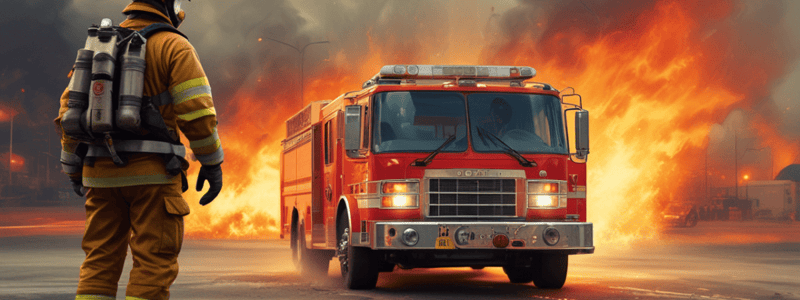Podcast
Questions and Answers
What is the primary focus of the UL Firefighter Safety Research Institute's research on fire dynamics?
What is the primary focus of the UL Firefighter Safety Research Institute's research on fire dynamics?
Understanding how fires grow and spread in homes to improve firefighter safety and efficiency.
What is the purpose of using full-scale structures with controlled ventilation in the research project?
What is the purpose of using full-scale structures with controlled ventilation in the research project?
To study the impact of ventilation on fire patterns.
What is measured by thermocouples in the experiment?
What is measured by thermocouples in the experiment?
Temperature at intervals from ceiling to floor.
What is the purpose of monitoring oxygen concentration in the experiment?
What is the purpose of monitoring oxygen concentration in the experiment?
How is the scene documented during the experiment?
How is the scene documented during the experiment?
What is the role of the technical panel of fire investigation experts in the research project?
What is the role of the technical panel of fire investigation experts in the research project?
What is the impact of ventilation on fire patterns according to the research?
What is the impact of ventilation on fire patterns according to the research?
How does the research project promote collaboration?
How does the research project promote collaboration?
What is the significance of replicating fires in the experiment?
What is the significance of replicating fires in the experiment?
What is the ultimate goal of the research project?
What is the ultimate goal of the research project?
Flashcards are hidden until you start studying
Study Notes
Fire Dynamics Research
- The UL Firefighter Safety Research Institute has been conducting research on fire dynamics for the past 10 years.
- The research focuses on understanding how fires grow and spread in homes to improve firefighter safety and efficiency.
Experimental Setup
- The project uses full-scale structures with controlled ventilation (opening doors or windows) to study the impact on fire patterns.
- Replicate fires are conducted with the building initially closed, then with openings made in subsequent tests.
- Probes measure temperature, gas velocity, and direction of hot gases and fresh air.
Data Collection
- Thermocouples measure temperature at intervals from ceiling to floor.
- Oxygen concentration is monitored at 4 feet and 4 inches above the floor.
- Pressure is monitored through taps in the wall.
- Cameras and sensors capture data on fire effects, such as ignition, flames, and smoke.
Investigation and Analysis
- The scene is documented with photographs before, during, and after the fire.
- Furniture is removed, and layers of the house are documented to analyze fire patterns.
- Data is analyzed with a technical panel of fire investigation experts to develop key findings and an online training program.
Impact and Applications
- The research aims to improve firefighter safety and efficiency by understanding fire dynamics and ventilation impacts.
- It also informs fire investigators about the impact of ventilation on fire patterns and origin.
- The project promotes collaboration between firefighters and investigators to improve overall fire safety and response.
Fire Dynamics Research
- UL Firefighter Safety Research Institute has conducted research on fire dynamics for 10 years to improve firefighter safety and efficiency.
Experimental Setup
- Full-scale structures with controlled ventilation (openings made in doors or windows) are used to study fire patterns.
- Replicate fires are conducted with the building initially closed, then with openings made in subsequent tests.
Data Collection
- Thermocouples measure temperature at intervals from ceiling to floor.
- Oxygen concentration is monitored at 4 feet and 4 inches above the floor.
- Pressure is monitored through taps in the wall.
- Cameras and sensors capture data on fire effects, such as ignition, flames, and smoke.
Investigation and Analysis
- The scene is documented with photographs before, during, and after the fire.
- Furniture is removed, and layers of the house are documented to analyze fire patterns.
- Data is analyzed with a technical panel of fire investigation experts to develop key findings and an online training program.
Impact and Applications
- The research aims to improve firefighter safety and efficiency by understanding fire dynamics and ventilation impacts.
- It informs fire investigators about the impact of ventilation on fire patterns and origin.
- The project promotes collaboration between firefighters and investigators to improve overall fire safety and response.
Studying That Suits You
Use AI to generate personalized quizzes and flashcards to suit your learning preferences.




